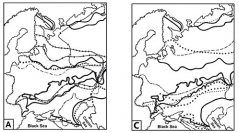

 Comptes Rendus Palevol
15 (6) - Pages 721-730
Comptes Rendus Palevol
15 (6) - Pages 721-730The last appearance dates and especially occurrences of amphibian and reptile species have a rather limited stratigraphic potential in Quaternary deposits. However, changes in their areas of distribution against the background of climate variations open some possibilities for biostratigraphy. Based on fossil assemblages of amphibians and reptiles, interglacial or periglacial conditions can be distinguished. Substitution of forest associations by those typical for forest-steppes or steppes within the limits of the modern forest zone can be attributed to climate aridization at the onset of a glaciation. Therefore, during paleogeographic reconstructions, it is important to determine a natural zone, instead of an assortment of possible biotopes. Glacial intervals for modern steppe zones can theoretically be visualized by the emergence of desert taxa. Distribution areas of amphibians and reptiles during interglacial optima show different outlines. They usually varied slightly, but sometimes the range of some species expanded (Bufotes viridis) or species disappeared (Strauchbufo raddei) from a large part of their original distribution. Such changes can be used to define large age intervals within a regional biostratigraphy.
Quaternary, Biostratigraphy, Amphibians, Reptiles, East European plains